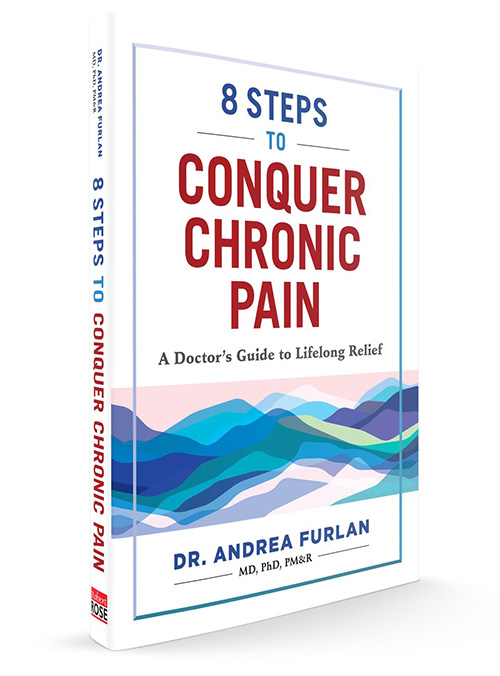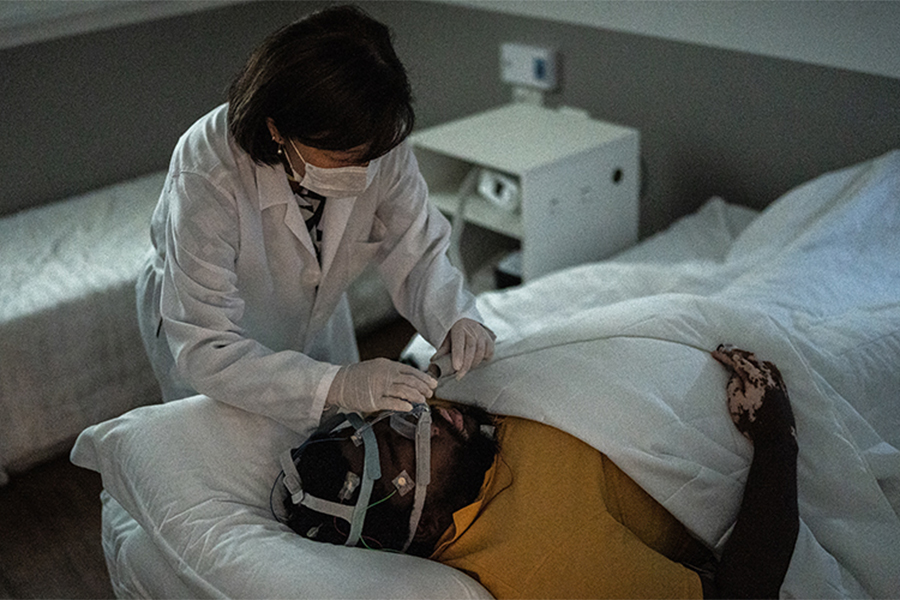“This book isn’t intended to diagnose or treat readers,” says Dr. Andrea Furlan, a pain expert and physician at Toronto Rehab. “It’s about giving them knowledge and tools to discuss their pain with their own health care teams.” (Photo: UHN’s KITE Research Institute)
Dr. Andrea Furlan is on a mission to help chronic pain sufferers restore their ability to live a fulfilling and happy life.
And, in her new book, 8 Steps to Conquer Chronic Pain, where she compares taking control of pain to climbing a mountain, Dr. Furlan pledges to be a trusted guide.
“What I find in my practice is that most people do not understand pain – especially chronic pain,” says Dr. Furlan, a pain expert and physician at Toronto Rehab, and Senior Scientist at UHN’s KITE Research Institute.
“With so many advances available to help people, I wrote this book to help get this knowledge out there. It reflects the same information I give my own patients suffering from pain and searching for long-lasting relief.”
Encourage people to take an active role in their own health
From advice on optimizing sleep, diet, and emotional well-being; to clarifying medication options; to exploring strategies to establishing long-term goals, the book guides readers, step-by-step, on a journey to lifelong pain relief.
“What I want readers to take away from the book is that people don’t need to be passive recipients of medical interventions; that they can take an active role in their own health; and that self-management is the solution to the problem of chronic pain,” says Dr. Furlan.
And while no two individuals journeys will look the same, it start with understanding the type of pain they have.
In the excerpt below, Dr. Furlan breaks down the types of pain people feel.
Once armed with this information, she encourages readers to use it to start meaningful conversations with their own physicians.
“This book isn’t intended to diagnose or treat readers,” she says. “It’s about giving them knowledge and tools to discuss their pain with their own health care teams.”

The following is an excerpt from 8 Steps to Conquer Chronic Pain
Pain can be compared to an alarm system of a house.
In a house, the alarm will sound when there is an intruder, water leak or smoke.
It is good that we have an alarm system for our body; otherwise, we could be damaging our body and not even realize it.
Nociceptive pain occurs when there is an injury or disease such as a fractured bone, appendicitis or inflammatory arthritis. The pain system will do what it is supposed to do. It will alert the brain to do something about it. The person has to stop what they are doing and seek medical care immediately.
Once the person receives proper treatment, the pain system doesn’t need to continue to be active, so it will deactivate itself. The injury heals or the disease is treated, and the alarm system becomes silent.
What does it feel like? Nociceptive pain is usually acute, sharp and can be precisely located when it happens around the skin, bones or tendons.
Neuropathic pain occurs when there is an injury or illness to the nerve system itself. It is similar to a situation where the wires of the alarm system have been cut or there is a short circuit in the system. Examples of this kind of pain are after a stroke, spinal cord injury, multiple sclerosis, shingles or nerve pain caused by diabetes.
What does it feel like? Neuropathic pain is described as burning, tingling, electrical shocks, throbbing, piercing and numbing. Examples include post-herpetic neuralgia, trigeminal neuralgia and diabetic neuropathy.
Nociplastic pain means the injury has healed or the disease has been treated and the wires are intact, but the alarm system is malfunctioning. The pain volume might be too loud (the person feels pain more intensely) or there are spontaneous false alarms. When pain lasts longer than the expected healing period, that means that the pain system has become sensitized or some modifications have occurred in how the pain is being processed. In this situation, the alarm system continues to alert the person beyond the healing period. Nociplastic pain is a kind of chronic pain. It can start as nociceptive pain, neuropathic pain or both.
What does it feel like? Nociplastic pain is characterized by diffuse, hard to locate, constant pain. There is no position that will alleviate the pain. Examples are migraine, tension-type headache, temporomandibular joint (TMJ) dysfunction, irritable bowel syndrome, chronic pelvic pain, painful bladder and fibromyalgia.
Nociceptive pain occurs when the alarm system is working well, neuropathic pain is when the wires are damaged, and nociplastic pain mean the alarm system is malfunctioning.


